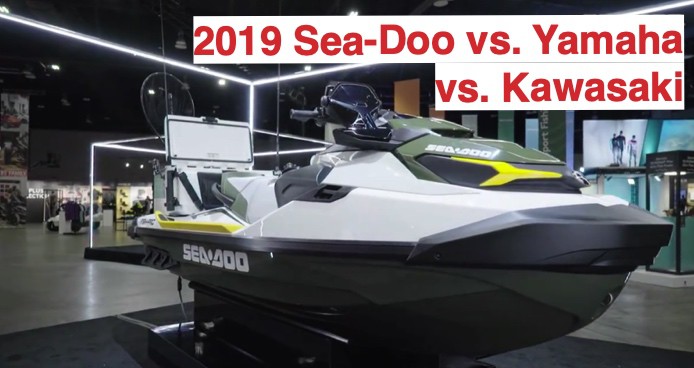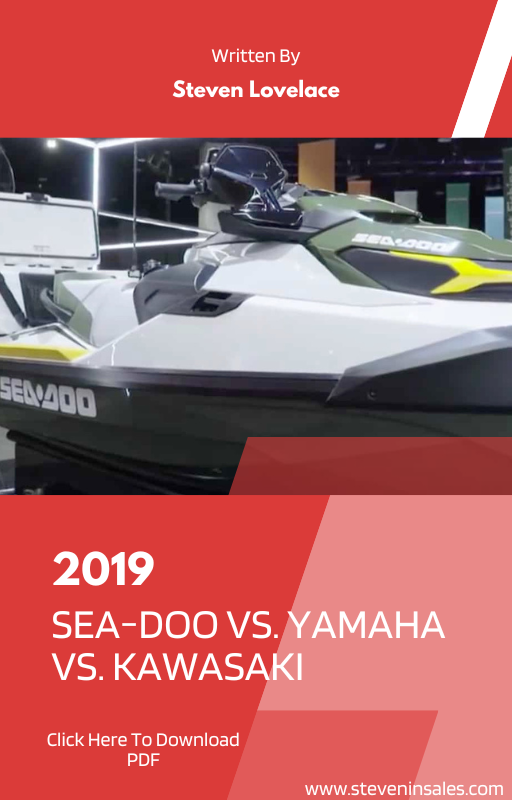Get the 2019 Sea-Doo vs Yamaha vs Kawasaki post as a PDF. It’s been converted to PDF to make it easier to read such a long document compared to the old way of it being a long article.
2019 Sea-Doo vs. Yamaha vs. Kawasaki

Author
Steven
I started working at a power sports dealership in 2007, I worked in parts, service counter, and as a technician before moving to sales in 2013. I created StevenInSales.com in 2014 to answer common watercraft questions I would get from people. Now managing the site full-time, I continue to provide advice and web tools for my readers about watercraft. I've owned several watercraft, with a Sea-Doo Spark as my current main PWC.

Hi! I am looking for a watercraft and of course to me the name I love is Kawasaki but I want something durable since I’ll be using it to rent them! What would you recommend me to purchase? Thanks in advance ?
Renters love Yamaha’s, mostly the VX models. Avoid Spark or EX. If you love Kawasaki there’s nothing wrong with them, they don’t change much which is a good thing because don’t fix what’s not broken.
Great article providing tons of help. I am trying to decide between a 2019 GTX 155 or 230 for $11,400 and $13,100 respectively (230 also has the sound system). I also am looking at a 2016 GTX 300 limited with 45 hours and they are asking $11,000. Which would you recommend? Not sure if the 155 gives the power I may want down the road. Thanks for your advice in advance.
The 155 will be more than enough power especially if you never had a jet ski before. The 230 and 300 is more ideal for people who want the most power possible or who do a lot of pull sports.
Thank you. Would it make sense to go with the 2019 GTX 155 or get the 2020 170?
Right now I would go with the 2019 GTX 155 because the rebates and warranty will be way better for it. The extra 15hp is not worth the extra cost if there are some leftover 2019 models.
Hi Steven!!
I wanted to ask if you were planning a blog entry on the new Sea-Doos?
Thanks!
I sure am, also working on one for Yamaha too!
I heard somewhere that the new SeaDoo lineup for 2020 will be announced in the next few days!!!!
September 10th.
I am looking to buy a new machine and can’t decide between the FX- HO or the SVHO the difference is about $2800 including tax. Do I really need a super charged engine?
From my experiences all jet skis are fast and paying in your case $2800 to go 10mph faster is not worth it. You’ll still get the same amount of fun and can still pull tubes just fine. Plus, the money you’ll save on gas for not having to feed a hungry supercharged engine is worth it if you ask me.
I’m facing a dilemma where the engine in my 2003 Seadoo RX-DI (130hp, 600lb) PWC is on the way out (again – previously rebuilt the top end). It hurts because I really love this ride, it does everything I need with the performance I want. I also need something relatively lightweight because I use an air-pump jetski lift when not riding, and I think the lift could only handle something slightly heavier than the RX-DI. I’m torn between a 2-UP Spark 90, Yamaha EXR, or Yamaha VX Cruiser.
Any thoughts on which would be a more similar replacement to the old RX? And it looks like Seadoo sells a VTS kit to add trim to the Spark, know anything about it? I use VTS on my RX all the time, and I can’t believe it’s not even an option on these rec-lite/recreation models.
Thanks
I’ve ridden an RX before and the closest thing to it would be a 3up Spark. Or better yet a 3up Spark Trixx if you really want extreme control over the VTS. The Sparks that have iBR will also have the option to add VTS, but the Trixx takes the VTS to a new level.
This is gonna sound like a tool of a question but I’ll be buying my 1st ski and I’m lost as all hell, your article helped me tons but the question I have is stability out of the WaveRunner ( cruisers ) and sea doo limited or fish pro which in your opinion would be the more stable on the water as far as rear boarding and side boarding from water?
The GTX Limited and Fish Pro will be the most stable as both share the same ST3 hull. That hull is super stable https://www.youtube.com/watch?v=dm_tgytKUXg The RXT, RXT-X, and GTX 155 also share the same hull too.
Steven, I bought a ’18 Sea Doo GTI SE 130 in December ’18 from one dealer that did NOT charge me Freight or set up Total pre-tax and excluding Doc and admin fees was $7895; wife wants me to buy another sea doo….found a ’18 Sea Doo GTI SE 90 near Atlanta for $7,643 but they are refusing to waive over $1,000 in freight and setup charges thus making the 90 MORE expensive, in essence than the 130….I am balking at buying….am I being too Hardheaded? is the ’18 GTI SE 90 with an out the door price with tax and freight etc. included of $9,624 a “good deal” when I paid $8,795 for the ’18 GTI SE 130? Ugh! Help?!?
You got an amazing almost too good to be true deal on that first one. But the key difference is that you got it in December when the dealer was desperate to sell because no one rides in the winter. You’re now wanting to buy during the summer and not only that but the promotions have vastly changed since then. The rebates are not as strong as they were in December and that is why the cost is so different, Sea-Doo is not supplying dealers with that great of a rebate because of the summer.
The ’18 GTI SE 90 is the last ’18 the dealer has in stock….just surprised they won’t budge on the “freight/setup/prep” charge of $1,000….just can’t get my head around paying “more” for a “lesser” model…even though I watcher your excellent review of the 90….
It’s a tough call, every dealership is different. I would have sold my last ’18 just to get rid of it. I have a feeling the current Sea-Doo manufacturer rebates are not that good and they can only go down so much on the price. Also, the margins are not that great on any Sea-Doo with a 90HP engine.
Thank you. Current rebate is $800 or 3 years and $300 I think
Hi Steven I have a couple questions….
1) Did any material features change on Yamaha VX Cruiser Limited between 2018 and 2019?
2) Is there any material diffference between comparable Yamaha and Sea-Doo engines? Are any of the categories above better for engine noise (for instance are the Yamaha VX engines materially quiet than the FX engines (same for Sea-Doo)?
3) Do the Yamahas with Low Power Mode enable you to accomplish something similar to the “training mode” that Sea-Doo offers? That’s a big feature for us as our kids will near driving age over the life of the PWC.
Thanks! This has been super helpful.
1) Not that I’m aware of, the focus in 2019 was for the FX models.
2)The material difference would be about the same, they’re both aluminum engine blocks. Both are now 3 cylinders, at least for Yamaha VX series and all of Sea-Doo models. For engine noise, you’ll want to go with the FX or GTX series of watercraft as they take that more serious. They have better engine mounts so less vibration and the exhaust is slightly quieter. I find the VX engine higher pitch compared to the Sea-Doo but it’s splitting hairs to be honest – both are not that loud. The noise of either at idle is no louder than a car at idle.
3)Some Yamaha models have a LOW-RPM MODE which is very similar to the Sea-Doo Learning key. Both limit the top speed of the craft to let someone learn the ropes of the PWC.
Sea Doo should listen to you on your fish pro ideas. The color does suck, but it is the perfect long distance cruiser. I bought one, not to fish off of, but for long distance trips. We do at least one long distance (500-600 miles), multi-day trip every year. The fish pro has the best combination of storage, comfort, navigation, and fuel tank capacity of any jet ski currently available. The 2 LinQ attachment points are another plus, just need a bigger cargo bag option that what is currently available.
If you were to buy one of the following fx cruiser ho or the Sea-Doo gtx 230 which one would you chose and why?
I would personally go for the Sea-Doo GTX 230 because the front storage is easier to get to. The Ergo seat is far more comfortable for longer rides and the craft is lighter and cheaper. Also, the accessories you could add later like the stereo system or ski pylon really helps sells the GTX.
Thanks for the valuable information! I was initially looking into yamaha vx but after seeing the new sea doo gtx in person with the modular seating, linq, and large platform, it’s clear that sea doo has put much thought into functionality. What is your opinion on the gtx 155 vs the 230? This will be my first pwc. What is the difference on fuel economy?
I would personally go for the 155 over the 230. They both have ECO options but the 155 doesn’t guzzle as much. Plus, it’s plenty fast as it is. As for a first time watercraft, this is a great option!
Hi. I want to get a pair of new 3 seaters for the Lake. Fastest uptake I can get for the money and big comfortable seats. I want to be around $10k each. I don’t know what to get. Thoughts ?
For $10k each, you’ll be stuck around the GTI and VX models if you want new. You could also spend more on one and go cheaper on the other – like a GTX 155 and Spark combo. This way you get a fast machine that is very comfortable but the kids get a more playful and affordable machine. If you don’t mind a couple of years old you could get some GTX or FX models for around that price used. If comfort and speed on both is a big deal then going used would be the best way to go. I have a used jet ski buyers guide here if you want to learn more about what to look for in used https://www.steveninsales.com/used-jet-ski-buyers-guide/.
Great. Very informativo